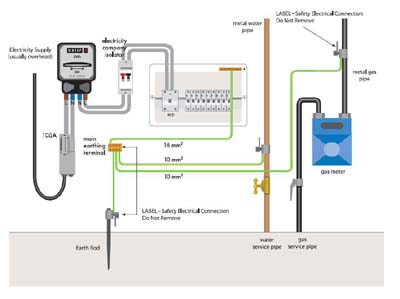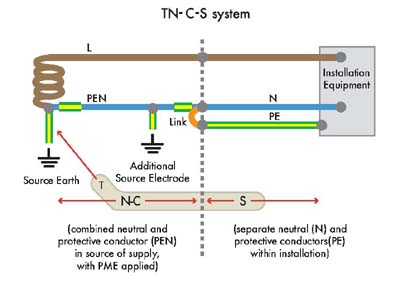Understanding Earthing Systems: A Detailed Overview
In my last post, I provided an introduction to the classification of earthing systems, briefly discussing the five types: TT, IT, TN-C, TN-S, and TN-C-S. This post will delve deeper into these earthing systems, explaining their design, applications, and advantages. A proper understanding of these systems ensures safety, reliability, and compliance with electrical standards.

What Is an Earthing System?
An earthing system is a critical component of any electrical installation, designed to protect equipment, property, and human life from electrical hazards. The type of earthing system chosen depends on the electrical system requirements and the specific application, such as:
- Consumer Power Supply
- Substations
- Offshore Platforms and Ships
- Underground Systems
- Generators
- Overhead Systems
Selecting the right earthing system ensures that the installation is both safe and efficient.
Types of Earthing Systems
1. TT System
- Description:
In the TT system, the power distributor provides no earthing; the consumer must install their own earthing protection system, including an electrode and other arrangements. The neutral and earthing conductors are kept separate. - Applications:
- Consumer power supply
- Telecommunication systems
- Premises with residual current device (RCD) protection
- Advantages:
- Free from high or low-frequency noise
- No risk of neutral failure
- Suitable for special applications requiring isolated earthing

2. IT System
- Description:
The IT system differs from the TT system in that the power supply distributor has no direct connection to earth or only a high-impedance connection. This system is not suitable for general consumer power supply but is used in specific applications like substations and generators. - Applications:
- Substations
- Generators
- Critical industrial installations
- Challenges:
- Limited fault detection
- Requires specialized monitoring systems
3. TN-S System
- Description:
The TN-S system connects the supply neutral to earth at one point at the source. The consumer’s earthing terminal connects to the distributor’s metallic armor, providing an efficient grounding system. - Applications:
- Underground power supplies
- Industrial facilities
- Factory power distribution systems
- Advantages:
- Reliable and stable earthing
- Effective fault return path
- Reduces electromagnetic interference

4. TN-C-S System
- Description:
The TN-C-S system combines the neutral and earth conductors in the power supply, referred to as Protective Multiple Earthing (PME). The combined conductor (PEN) carries both earth fault currents and neutral return currents. - Applications:
- Consumer premises
- Residential and commercial buildings
- Advantages:
- Cost-effective due to combined wiring
- Reliable fault current return
- Provides consistent earthing for large networks

5. TN-C System
- Description:
The TN-C system uses a single PEN conductor to serve both as the protective earth (PE) and the neutral (N). The PEN conductor is often part of the cable sheath. - Applications:
- Ships
- Offshore platforms
- Specialized installations
- Challenges:
- Not suitable for RCD-protected systems
- Higher risk of neutral failure leading to safety issues
Key Considerations in Earthing Systems
- Safety: Proper earthing ensures that fault currents are safely discharged, minimizing risks to life and equipment.
- Compatibility: The chosen system must align with the power supply and application requirements.
- Compliance: All earthing installations must meet local and international standards.
- Noise Reduction: For applications like telecommunications, the system must minimize electrical noise.
Conclusion
Each type of earthing system serves a unique purpose, catering to specific applications and environments. From the TT system‘s suitability for consumer premises to the TN-C system‘s specialized use in ships and offshore platforms, selecting the right system is vital for ensuring operational safety and reliability.
Understanding these systems empowers electricians, engineers, and technicians to design and maintain installations that are both efficient and compliant with safety standards. Stay tuned for more in-depth discussions on individual earthing systems and their testing methods!

Topic is very beautiful and important information in it, God bless you from all harm, thank you very much
Thanks bro..glad to shared the knowledge :D
i’m going to make a project on earthing…
iam wire man from sent joseph training center i need job.my contact
0716470616.
thank u sir i am trying lo learn about electrical motor wiring by ur drawings thank u so much sir.
Good technical practical information, for day to day works
Thanks
your perfect
Don’t say like that :D im still in leaning process :D
Thanks for sharing information but give me more information
superb knowledge…plz keep sharing …God bless u
Thanks…My pleasure :D
I found good knowledge from this link page
Odlično, nema boljeg objašnjenja
is real a pleasure having u online to share some difficulties in electrical technology, may God provide u abundantly and that may u leave long.
does earthing necessary for installation of boom barrier gate….do we have ned earthing special like house…
thanks for sharing what u have in u,God bless u sir. But i stil want to know how a house that is built on rock as high as 1000km above sea level of 200km.thanks once again